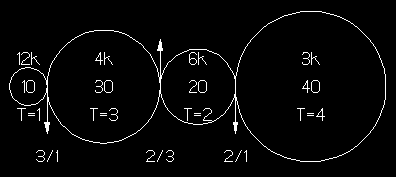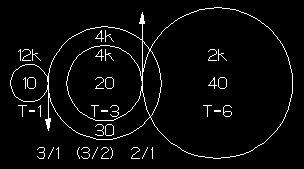Idlers are used to adjust input to output shaft spacing, to power
parallel shafts and to reverse direction. Many examples exist in N Scale and
Athearn's gear boxes are good examples of multiple sizes in one train. The
number of idlers does not effect overall gear functions.

Using the left gear as the input with 10 teeth, T = 1 oz-in and RPM = 12 K
CW, the second gear is driven at a 3:1 ratio yielding the results shown but
rotates CCW. Each pair follows the same rules. An odd number of idlers
preserves the rotation direction, While an even number reverses it.
The important thing to note is the relationship between the input and output gears. If there were no idlers between them the ratio would be 4:1 and yield identical results. The product of the ratios yields:
Total ratio = 3/1 * 2/3 * 2/1 = 4/1
COMPOUND (STEP) GEARS

Here the two center gears are fixed on the same shaft resulting in a step or
double reduction gear. The relationship of the first two gears does not
change, but since the second and third gear are fixed on the same shaft, their
torque and RPM are the same. These are transferred from the third to the
output gear by their ratio. Total ratio is again the product of the ratios.
Total ratio = 3/1 * 2*1 = 6/1
Since in most regear projects, the input is often a worm or the smallest
pinion available and output gear is limited by driver size, these are selected
first. Dividing their ratio into the total desired yields the step gear ratio.
(Shown in parentheses)
Step ratio = (6/1) / (4/1) = 3/2
The step gears can be any combination that yields the ratio:
Step ratio = 3/2 = 15/10 = 30/20 = 36/24
Selection is by fit.
BACK
BACK TO GEAR FUNCTIONS
BACK TO REPOWER DON'T KNOW WHY
HOME
|


